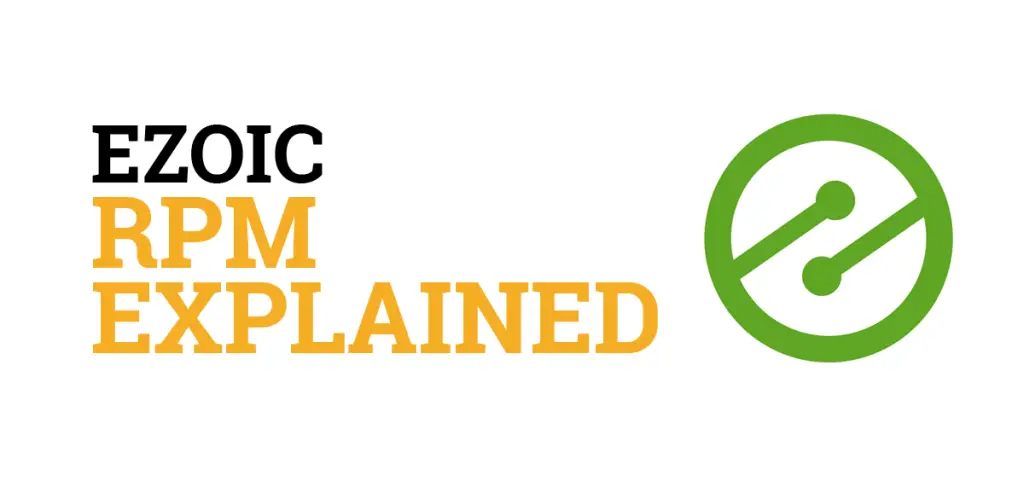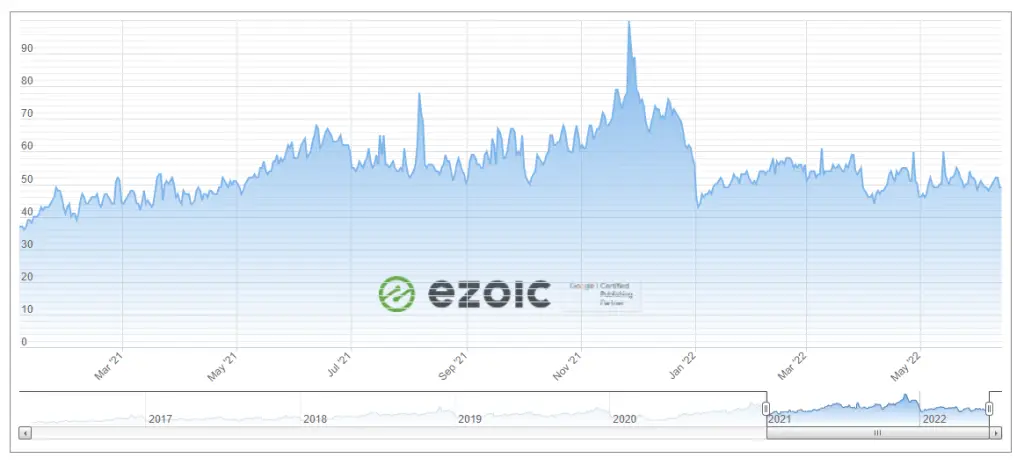In this article, you’ll learn all about Ezoic RPM rates.
As you’ll discover below, Ezoic average RPM for ad revenue varies across every website and industry; however, there’s a general range of earnings you can expect from a site that’s monetized with Ezoic’s platform which this guide will cover.
Additionally, Ezoic uses another metric to track and measure the estimated total ad revenue for website publishers called EPMV. You’ll learn all about what that is below as well as find a list of the highest paying RPM (and EPMV) categories for making money with display ads.

What Is Ezoic RPM?
RPM stands for Rate per Mille or Ad Revenue per Thousand Impressions (Mille = 1,000 impressions). RPM is calculated by dividing estimated earnings by the number of ad impressions, then multiplying by 1,000.
Ezoic does not use RPM as an earning metric for website publishers; however, RPM is used by advertising platforms like Google AdSense, Mediavine, Adthrive, Monumetric, etc, to represent the paid rate for 1,000 ad impressions.
For example, if you earned $300 from 50,000 ad impressions, then your ad RPM rate would equal $6. ($300 / 50,000) * 1,000 = $6.00.
Ezoic Average RPM Rates
The average Ezoic RPM is $10-40 for 1,000 views. This means that your website can earn on average $0.01 to $0.04 per page view with Ezoic’s advertising platform.
However, you need to keep in mind that Ezoic calculates ad earnings with a metric called EPMV which represents Earnings Per Thousand Visitors (or session RPM). As you’ll discover later in this guide, EPMV is a much better metric than RPM for measuring the total revenue you can earn for each user session on your website.
You can learn more about how much does Ezoic pay here per 1,000 views if you’re interested in this specific topic. Or you can get started with Ezoic today by using my Ezoic affiliate link here to sign up and begin the integration process. You can typically get set up and approved within 24 to 48 hours to start monetizing your website with display ads.
What Is a Good RPM?
A good RPM is between $1 – $50 and possibly more for ad revenue. There are many factors that impact the RPM value for website publishers who monetize their sites with display ads.
Because of the multiple variables involved that account for ad revenue, it’s difficult to establish a good RPM for one website compared to another, even if they are in the same industry. Therefore, every website publisher is going to have a different RPM metric that’s considered good for their site.

Factors That Affect RPM Ad Revenue
Below is a list of the top factors that can affect your website’s RPM ad revenue:
- Industry or niche
- Content types you’re targeting
- Content quality
- Content length
- Geo-location of visitors
- Demographics of visitors
- Seasonality
- Topic trends
To help you understand how these factors impact your advertising RPMs for Ezoic, Mediavine, Adthrive, Monumetric, Google AdSense, etc, consider the following two examples:
- Website A is in the car insurance industry, publishes commercial content with high buyer intent (i.e., reviews and product pages), and gets most of its visitors from the United States.
- Website B is also in the car insurance industry, but only publishes informational content with low buyer intent (i.e., how-to guides and industry definitions), and gets most its visitors from the United States.
By comparing these two example websites above, you can easily estimate that website A will have a higher RPM than website B. Why? Because website A is focusing on commercial content with higher buyer intent and advertisers are willing to pay a higher Cost per Thousand Impressions (CPM) to have their ads appear on those web pages than they are for the informational content on website B.
Therefore, even though both websites are in the car insurance industry, the RPM rates will vary greatly for both websites, which means you cannot compare them equally to each other by saying one website has a good RPM vs bad RPM for Ezoic, Mediavine, Adthrive, Monumetric, Google AdSense, etc.
You can check out my complete guide on how to increase Ezoic earnings here to learn the top ways to make more ad revenue with this platform.
Highest Paying RPM Industries for Ezoic and Other Ad Platforms
According to a blog post on Ezoic about RPMs and eCPMs (explained next), the most valuable website categories and keywords for advertisers include:
- Insurance
- Loans
- Mortgage
- Attorney
- Credit
- Lawyer
- Donate
- Degree
- Hosting
- Claim
- Conference Call
- Trading
- Software
- Recovery
- Transfer
- Gas/Electricity
- Classes
- Rehab
- Treatment
- Cord Blood
If you were to create a website based on one of these categories or shift your content marketing strategy to include more articles in these topic areas, then you could see an increase in your Ezoic RPM rates (which is technically EPMV as you’ll learn below).
What Is eCPM?
eCPM stands for Effective Cost per Thousand Impressions. eCPM is essentially the same thing as RPM (or Rate per Mille) which is a publisher-side ad revenue metric.
It’s important to understand both of these advertising terms because some ad networks will refer to publisher earnings as eCPM instead of RPM. Although the acronyms are different, each metric shows you how much ad revenue the publisher has generated on average from 1,000 ad impressions on the website.
Ezoic Uses EPMV Instead of RPM
You may have landed on this web page trying to find out what are Ezoic average RPM rates. However, as mentioned earlier in this guide, Ezoic uses EPMV instead of RPM values to measure ad earnings for website publishers.
This is an important concept to understand about ad revenue tracking with Ezoic because the EPMV (or Earnings per Thousand Visitors) is a much better way to estimate how well your website is performing with display ads. That’s because EPMV takes into account the total revenue for all sessions on your website; not just a single page like RPM calculates.
As Ezoic explains it, “Measuring and tracking EPMV on a site-wide basis and on a landing page basis can essentially answer this question more efficiently than any other metric. This will help publishers see the exact value of a user session and how it has progressed over time, and also ultimately discover which pages are triggering the highest value sessions.”
In other words, knowing the EPMV rates for your website can help you figure out which types of content earn you the most ad revenue on both a page-level basis and for the total user sessions. RPM rates only report on a page-level basis; not the entire website, which is a very limited data set for making content publishing and optimization decisions.
For example, a website that’s monetized with an advertising network that reports ad revenue earnings with RPM rates will show you how a single web page is performing for revenue. Therefore, if a page is earning a $35 RPM, then for every 1,000 visitors that land on that page you’re earning an estimated $35.
However, this doesn’t tell you how valuable that web page is for the entire user session (i.e., the visitor’s journey throughout your site). Only EPMV rates can give you that detailed revenue information which is one of the top reasons why Ezoic is trustworthy as a long-term platform for monetizing a website with display ads.
Another example will help make this more clear. Let’s say there’s a web page on your site that attracts a lot of organic search traffic but those visitors don’t just consume the information and leave. Instead, they navigate to 3 other pages (on average) which results in viewing more total ads and delivers a $50 EPMV.
The EPMV rate reveals that this single web page is much more valuable to you as a publisher because it generates more ad revenue in total. For some reason, that content is keeping people on your website longer and encourages them to view more web pages, which earns you more ad revenue for the entire user session ($50 per thousand visitors). The average RPM rate would only tell you how much the individual web page is worth for a single view regardless if that user navigated to another web page or not.
One of the top competitors of Ezoic that uses RPM for reporting ad revenue is Mediavine. You can read my full comparison of Mediavine vs Ezoic vs here. If you’d like to join Ezoic’s platform, then I invite you to use my Ezoic affiliate link here to sign up and get started with standard integration. Setup and integration can be approved in less than 24-48 hours after creating an account.
Ezoic Ad Revenue Index
Earlier in this article, you learned that there are many factors that can impact the average RPM rates for Ezoic, Mediavine, Adthrive, Monumetric, Google AdSense, and other advertising networks on a site-level basis. However, your average RPM earnings can also be affected by market conditions and the spending rate by advertisers.
To help publishers gain more insight into why their ad revenue is increasing or decreasing as a result of something occurring with their website versus global market conditions, Ezoic publishes an Online Ad Revenue Index for you to compare your daily and monthly earnings to.

As explained by Ezoic, “The Ad Revenue Index takes a statistically relevant sampling of global sites (of all sizes and demographics) and collectively indexes their ad earnings and displays them in a running real-time aggregate.” This data can help you quickly analyze if there’s an overall upward or downward trend in advertising spending that’s outside of your control as a website publisher.
If you’d like to learn more Ezoic’s platform, you can visit these other pages about what is Ezoic and get a list of Ezoic requirements to get started with this platform. Ezoic also offers a Premium program that helps publishers earn even more money with ad revenue. You can read a detailed Ezoic Premium review here.
To get started using Ezoic now, you can use my Ezoic affiliate link here to sign up. Setup and integration can be approved in less than 24-48 hours after creating an account.
Ezoic RPM Rates Summary
I hope you enjoyed this guide about Ezoic RPM rates.
As you discovered, Ezoic average RPM ad revenue is based on EPMV metrics that track the total earnings per thousand visitors for the entire user session; not just on a page-level basis. Also, the average earnings for every website will be different based on a number of factors that impact the ad revenue generated by each visitor.

SEO Chatter is dedicated to teaching the fundamentals of search engine marketing to help marketers understand how to increase organic website traffic and improve search engine rankings.
